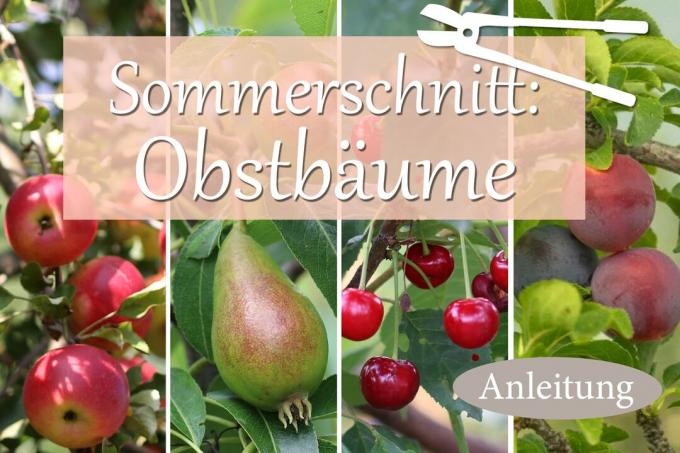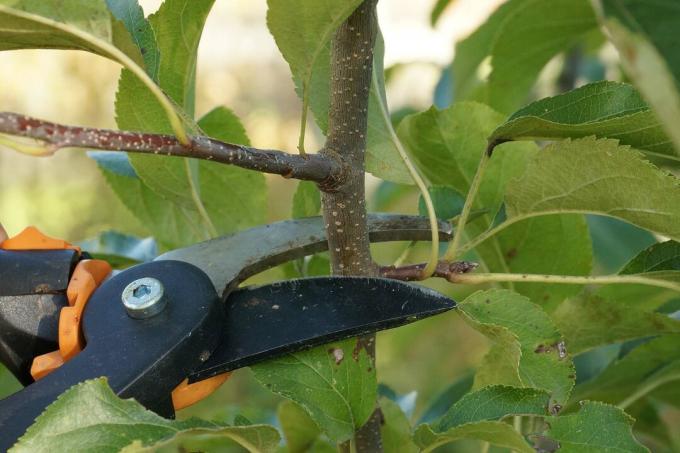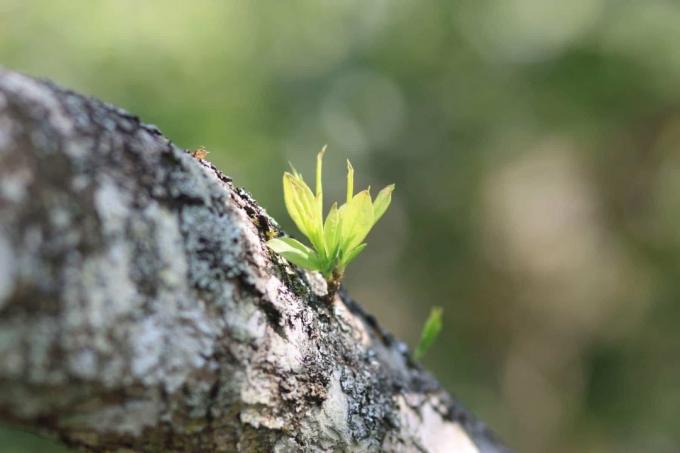
Table of Contents
- Summer pruning has advantages
- Best time
- Pruning apple and pear trees
- Summer pruning for morello cherries
- pruning of plums
- frequently asked Questions
Pruning a fruit tree in summer is becoming more and more important. This can stimulate flowering and ripening of the fruit. With the right instructions, only a few cuts are necessary.
In a nutshell
- Summer pruning mainly in July/August
- restricts shoot length growth
- promotes ripening of the fruit
- better wound healing
- mainly thinning of the crown
Summer pruning has advantages
Summer pruning of fruit trees is becoming more and more common. If the fruit tree is full of leaves in summer and fruit is being formed, you can definitely grab a saw and scissors. Pruning during this time of year comes with a few benefits:
- Cessation of long shoot growth
- Stimulating the formation of fruit wood for the coming season
- better ripening of the fruit
- thus better quality of the fruit
- higher harvest possible
- faster wound healing
- better defense against bacterial and viral infections and fungal pathogens

Best time
Choosing the right time is important when pruning fruit trees in summer. It must not be started too early. Longitudinal shoot growth must be complete. As a rule, the growth of the main stem stops at the end of July with the formation of the terminal bud. Then there is already a slight discoloration of the leaves. The nutrients are extracted from the leaves and used for fruit formation. Now it's time for the summer cut:
- ideal time for pruning: July/August
- It can be postponed from the end of June to the beginning of September
- Completion by mid-September at the latest
- then enough time for the wound to heal
- Cut back on dry, cooler days that are not too sunny
Notice: Fruit trees often produce shoots that grow upright, so-called water shoots. The removal of these water shots takes place in June at the Juniriss. They are then simply torn off vertically downwards.
Pruning apple and pear trees
The cutting of Apple– and pear trees in summer may only fail slightly. It should take place in August. The crown is mainly thinned out so that enough light and air can get inside and the fruit can ripen well. In addition, the treetop can dry off more easily and quickly after a rain and fungal diseases hardly stand a chance. First, however, you should check all the main branches that form the foundation of the crown. If these are too close together, you can remove the branch in question.

Below is a brief guide to cutting:
- Remove all leading branches that are too close together.
- To do this, make a safety cut from below, a hand's width away from the trunk.
- Then saw off the guide branch a little further outwards.
- Remove the remaining stub directly on the trunk, except for the branch bulge, with an oblique cut.
- Cut off all inward growing, too dense, crossing and diseased shoots at their base.
- Now cut off the rising shoots that grow vertically upwards down to the branch.
- Then thin out medium-thick apple shoots to a wreath with 2 to 3 leaves at the point of attachment (rosette cut).
- Already attached, long, vertical fruit wood is shortened to two pairs of leaves (stub cut).
- Finally, remove all small shoots from the trunk (stump cleaning).
In the case of late-ripening varieties, however, the fruit shoots should not be shortened. Otherwise the fruits would be deprived of the basis of their nutrition. As a result, their maturation is slower and therefore takes longer. Furthermore, when pruning fruit trees in summer, you should make sure that not too many shoots are removed. Otherwise the supply of nutrients to the fruit is no longer fully guaranteed. Likewise, fruit hanging in the shade should not be left in the blazing sun after cutting. Otherwise you can burn up quickly. get sunburned.

Notice: Sometimes in June fall not many unripe fruits are shed from the tree itself, then picking is required at the end of June. Only one or two fruits should remain per fruit cluster. However, the tree must be in full yield. He is then usually 5 to 15 years old.
Summer pruning for morello cherries
With this cherry, the flowers appear on one-year-old wood. The shoots can bare very quickly and hang down like whips. You can prune this fruit tree after the summer harvest.
- transfer three quarters of the whip shoots to newly sprouted side shoots
- start cutting just above new growth
- leave a quarter of the whip shoots
- cut back harvested fruit shoots
- Shorten annual shoots to 20 to 25 cm
- leave only three annual shoots for every 10 cm of the length of the leading branch
- remove remaining young shoots
- Cut out shoots that are too steep, upright, too dense, inward and crossing
- remove the oldest leading branch every 2 to 3 years except for the astring
- Cut sweet cherries

Fruiting occurs only on two- to three-year-old shoots. A pruning is generally done in late summer or after harvest. Here's a quick guide on how to do it:
- Shortening of long side shoots to an upward pointing eye
- Remove all thin, inward-growing shoots at the base
- cut out old and non-fruit-bearing wood
- Shorten drooping shoots above a new side shoot
- Cut off competitive shoots on the central stem at the point of attachment
- Leave short shoots with whorled bud stands on the tree
If there is already a large number of overhanging branches, a rejuvenation cut must be carried out. However, you should only remove branches with a diameter of up to five centimeters. Otherwise, what is known as gum flow can quickly occur, in which the tree abs a resinous, sticky, amber-colored liquid.
pruning of plums
As early as June, all the water shoots have to be torn out with the June tear. A pruning then takes place regularly in August, but very cautiously.

- Remove all inward, too dense, upright growing shoots at the base
- All three-year-old and older fruit branches are trimmed just above the two-year shoot
- Prune competitive shoots back to cones
- alternatively derived from biennial side shoots
- Side shoot should bear flower buds
- Cut off thin side shoots before new young shoots
Notice: Always use a sharp tool for cutting secateurs or saw can be used. Thisyou should carefully disinfected with alcohol before and after usein.
frequently asked Questions
A summer pruning on fruit trees restricts shoot growth. In contrast, winter pruning stimulates shoot growth in the new growing season.
It always depends on the type of fruit. As a rule, however, fruit trees are cut back twice a year. A pruning takes place in winter and in summer. This guarantees a larger harvest.
Regular pruning will result in a better harvest and the fruit will be of better quality. Without pruning, a fruit tree is no longer very vital over time and is extremely susceptible to diseases. The harvest is low and the fruits are small, since dense branches growing into the crown allow no light and air to reach them.
According to the Federal Nature Conservation Act, from 1 March to 30. September cutting off, raising and removing hedges, bushes and other woody plants is prohibited. During this time, only light care and shaping cuts are allowed, but only if no birds are breeding there.
